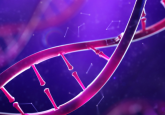Adapting nanopore sequencing for proteins

Using an ionic solution, protein sequences can now be pulled through a nanopore.
Researchers at the University of Groningen (The Netherlands) have found a way to transport a protein through a nanopore, which could lead to protein sequencing technologies that are comparable to the handheld devices available to sequence DNA.
DNA can be sequenced with handheld devices that use nanopore technology. A single strand of DNA is pulled through a tiny hole (a nanopore) embedded within a membrane. Changes in the electric current are monitored as the nucleic acids pass through, which produces a signal that is decoded to produce the DNA or RNA sequence. Steps have been made towards using nanopore technology to sequence proteins, but this has not been possible as proteins are “like cooked spaghetti,” senior author Giovanni Maglia explains. “These long strands want to be disorganized, they do not want to be pushed through this tiny hole.”
Proteins have a weaker charge than DNA and can either carry a positive or negative charge, meaning they cannot be pulled through the nanopore in the same way. Maglia and the team dragged a solution of ions through the nanopore with an electric field, pulling the protein with it. “We didn’t know whether the flow would be strong enough. Furthermore, these ions want to move both ways, but by attaching a lot of charge on the nanopore itself, we were able to make it directional.”
 The protein–protein interaction promoting Parkinson’s disease
The protein–protein interaction promoting Parkinson’s disease
What role do protein–protein interactions play in the accumulation of α-synuclein in the brains of individuals with Parkinson’s disease (PD)?
The researchers engineered a system to produce the strongest possible flow without proteins. Computer simulations then revealed that this force on a protein would be comparable to the force of the electric field applied to DNA in nanopore sequencing.
They applied this system to a challenging protein with many negative charges, which would make the protein want to go in the opposite direction of the flow. The flow produced by the ionic solution was strong enough to pull this protein through the nanopore. “Previously, only easy to thread proteins were analzyed. But we gave ourselves one of the most difficult proteins as a test. And it worked!” Maglia remarked.
Maglia has created a new startup called Portal Biotech to commercialize this protein nanopore sequencing technology and make it available to other labs and in clinical settings. Maglia concluded, “with this latest research result, we have the missing piece that we needed to make protein sequencing happen.”





